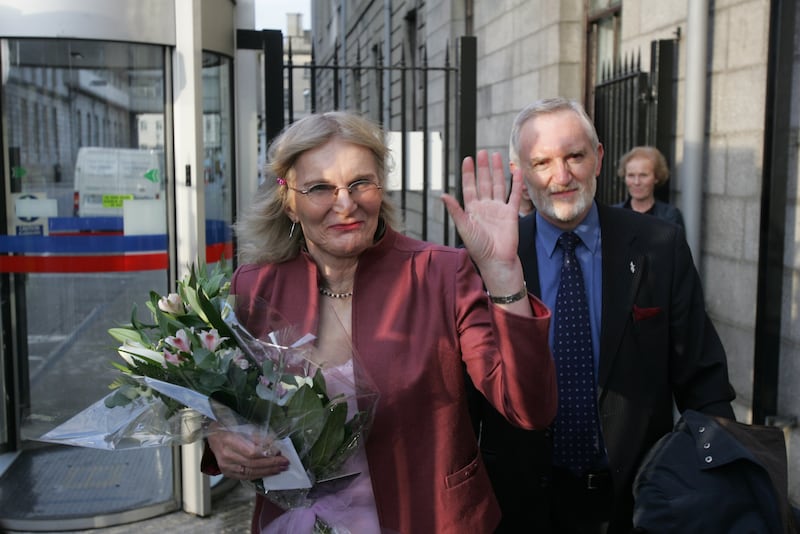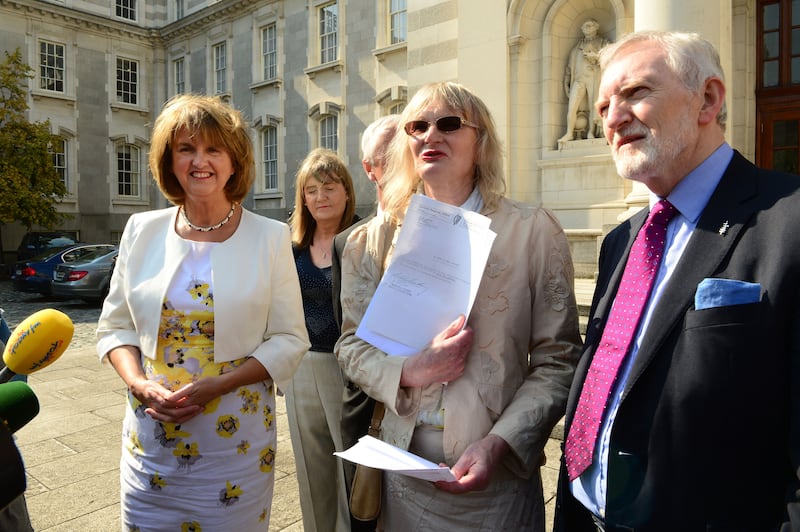Dr Lydia Foy lives in a small terraced house just outside Athy, Co Kildare. It was derelict when she bought it more than 25 years ago, when she was in the midst of a long battle for the right to change the gender on her birth certificate. There are lots of files and books and documents in the house, but she really brought me here to show me her art.
Foy, who is 77, is a prolifically creative person. She once grew a record-breakingly large foxglove in her garden. “That was just a figary I had at the time,” she says and laughs. “If I had my way, I’d have pheasants around the place and more protection for the badgers and foxes and everything. Without the birds and the bees there’s no us.”
She plays music – fiddle, mandolin, harmonica. She picks up the latter at one point and expertly plays a few bars of The Last of the Summer Wine. While having her photo taken, she sings an old Bing Crosby song called I’m Drifting Back to Dreamland. She’s very good company.
And she paints. The walls of her hall and stairway and kitchen are lined with her paintings. There are beautifully rendered reproductions of art by Paul Henry, Vermeer, Gainsborough and DaVinci. There’s a painting of Audrey Hepburn and one of the famous National Geographic cover featuring the Afghan refugee Sharbat Gula. In the kitchen there’s a large “selfie” she painted of herself with her little dog Bambi. Bambi herself runs around our feet as we talk, wearing a pink jacket to keep out the cold. “The poor lady is old now,” says Foy.
Sally Rooney: ‘I enjoy writing about men ... the dangerous charisma of the oppressor class’
Alzheimer’s: ‘I’ve lost my friend and my companion,’ says Úna Crawford O’Brien of fellow Fair City actor Bryan Murray
Ryan Adams at Vicar Street: A gig that nobody will forget anytime soon, but perhaps not for all the right reasons
There are also photographs of her with friends and family from across the years – at the Pride parade when she was the grand marshal in 2010, at the Dublin marathon and standing alongside people such as President Michael D Higgins and Joan Burton. There’s a framed cover of trans pioneer Caroline Cossey’s My Story, a book that had a huge effect on her when she was figuring out her trans identity. There are little collages here and there of winged women. She has always had vivid dreams that involve time travel and flying. The winged woman, she explains, is herself.
[ From the archive: Compensation paid to Lydia Foy over gender recognition failuresOpens in new window ]
And Foy has written books, though none are published. She thinks she needs a mentor to help with that. She shows me a hardback self-made copy of a book she wrote all about rhubarb. She spent years working on a lyrical play called Plagio, about an old theological concept involving the possession of a person’s soul. Joan of Arc, she tells me, was accused of “plagio”. She started working on this when she was in college in UCD many decades ago. She was sitting beside the Dodder river and the opening lines came to her.
Creativity, she says, “that’s what keeps me sane”.
In Foy’s local pub, the Auld Shebeen, Foy orders a glass of wine with her salmon dinner. “I told him he might get more information out of me if I had a glass of wine,” she explains to The Irish Times photographer.
She’s wearing a wine-coloured jacket with a glittering poodle brooch on the lapel. She’s a bit nervous about the interview, she says. “I was hoping that this would be more about me as a person rather than all the baloney with the courts.”
She has a blue folder with her and takes out a photo of herself as a very young child. “I was a leanbh ban,” she says. “A fair child. At that stage I could just be me because there was no gender at that stage. My ma showed me a photograph of an old uncle and said, ‘You’ll be like that now, when you get old’ and it gave me nightmares, because I knew that wasn’t me.”
Later she says: “I was born ... ‘hybridised’. That’s a word I love. It’s respected in nature, but not in humans, unfortunately. I would have said I was ‘hybridised’.”
I was being told by my family and everybody I knew, dress, act and behave like a man or you’ll have access to nothing. I was ridiculed by the press. None of the medical profession would stand by me
— Dr Lydia Foy
Her first communion had a huge impact on her. “There was an obvious [gender] divide,” she says. “I was up in the church, and I was sort of sitting a few rows back and I remember feeling I had nowhere to go. I actually had tears.” She sighs. “It was a tough society so you had to toughen up and conform. Which I tried to do.”
It was a difficult time to be different in Ireland. She developed a rich imaginative inner life. “I was into escapism. I could fly. I could levitate ... You create a secret world.” She still does this. She tells me in great detail about a recent trip she took to a market in China. Does she mean she dreamt it? She laughs. “You tell me. What is reality? I was bashed to bits in school, very rough and nasty. I was walloped. I was called feather brain, scatter brain ... You have to have an escape of some kind.”
In UCD she studied dentistry but went to theological discussion groups and wrote and joined the choir and the music society. “Dentistry was for those who were thinking of money and big cars and all the rest. That wasn’t my dream of life at all.”
She couldn’t come out as a trans woman. It just wasn’t possible at the time, she says. “You’re not born with the book, so you’re trying to look for explanations the whole time. When you look it up you see sort of nasty stuff about it.”
Like what? “Usually they said, ‘See under ‘sexual deviancy’. People liked to ridicule it. That was the stage we were at.”
As far as everyone was concerned, she was conforming. She became a dentist. She married and had children. “I went on until I collapsed in a heap.”
Her first issue, in the late 1980s, was a serious physical problem with the blood supply in her right leg. She required surgery. While in hospital she asked for a psychiatrist but couldn’t get one. “They said it’s only the surgery and you’ll be all right.” She was struggling. “I was in very bad shape ... I tried to carry on, and I ended up not being able to eat and I collapsed and was taken again into hospital.”
Eventually people listened to her and she found specialists in Dublin and the UK who understood trans issues. She began her transition but that’s when her legal problems began. Her marriage broke down and she ended up in the family courts. Her gender identity became a core issue. She was denied access to her children.
“I was being told by my family and everybody I knew, dress, act and behave like a man or you’ll have access to nothing. That was it. I was ridiculed by the press. None of the medical profession would stand by me. And the church said I was going to turn Ireland into a psychiatric institution ... I was treated like the worst form of life by the family courts ... I was told to cover my face or go out the back door. And I said, ‘I’m not a bloody criminal’. But then if I didn’t do that, of course, I was a selfish bitch. You couldn’t win.”
I never understood people blowing whistles and marching and making a big racket. I couldn’t really understand that until I found out the hard way that it was necessary sometimes
— Dr Lydia Foy
Flac (the free legal advice centre) indicated it might be able to help and asked her to list 10 things she wanted assistance with. The only one they thought they could help with was number 10 on the list: fighting to legally change her birth cert to reflect her gender.
What was higher up on her list? “Fair treatment, a right to a fair hearing, a right to reply, a right to an accurate representation of what happened in court.” With the case to amend her birth cert, she says, “I was clutching at straws ... My job was gone. I was very unwell. I didn’t even get sickness [benefit]. I had run out of all options.”
With the help of barrister Bill Shipsey, she took the first case in 1997. It was before organisations such as TENI [Transgender Equality Network Ireland] or Belong To; Foy was out on her own. She shows me a leaflet she printed herself in 2000. It includes a charcoal self-portrait she made when she was particularly unwell and the term “Congenital gender disablement”. “It’s a very unusual leaflet because I was on my own with terminology.”
She says there were numerous people in Flac who helped her hugely including Shipsey and solicitor Michael Farrell. “They all listened and for once in my life some of the pressure was off because I could actually tell them what was true.”

Did she get much support from other people over the years? “A lot would have sympathised but wouldn’t have been brave enough publicly,” she says. “Some people threw stones at me. Some if they said ‘hello’, they thought they were brave. And you’d hear them behind your back, ‘Isn’t it a sad case’.
“There were exceptions. There always are. A few of the older people. People were trying to get them to rabble rouse and they said, ‘Well that’s not the person I knew’ and they stood by me. And the stories were very exaggerated and very nasty. Go back and look at some of the papers.”
The first case failed though the judge was sympathetic to her plight. There were three cases in total and it was a long, complicated legal process. She struggled financially over the years. Her dentistry job was gone. She did back-to-work courses. She did a computer course, a psychology course and a business course. She joined local groups.
Did she find acceptance there? “A superficial sort of acceptance,” she says. “There were exceptional people here and there. A lot of people would come along for some of the course, but then it went on so long you wouldn’t expect them to stay with you indefinitely. Friends sort of came and went, but that was understandable. They had their own lives.”
In 2007, after her case was referred by the High Court, a judge found that by not providing Foy with a mechanism to change her birth cert the State contravened the European Convention on Human Rights. The State challenged this initially but withdrew its appeal in 2010 and set up an interdepartmental committee on the legal recognition of transgender people. After Foy took a third court case in 2013, legislation was finally introduced that allowed her to change her gender on her birth certificate. The Gender Recognition Act that allows trans people legally change their gender was introduced in 2015.
[ ‘My country finally recognised me for who I really am’Opens in new window ]
Left to her own devices, Foy would never have become an activist, she says. “I never understood people blowing whistles and marching and making a big racket. I couldn’t really understand that until I found out the hard way that it was necessary sometimes. I thought I was the worst person in the world to do it. I had family complications. I was older. A younger person wouldn’t have had the same trouble.”
She remembers something. “They told me not to have a nervous laugh in court. I’m the sort of person who’d think of something stupid [at the wrong time]. It was part of the escapism.” Ultimately, she didn’t have a choice, she says. “If you corner an animal they’re going to fight back sooner or later.”

Would she have advice for other people battling for their rights? “I learned one big lesson early on,” she says. “Even if I couldn’t afford a coffee, I had to be able to afford a photocopy. Keep the original documents because they were so arrogant they made mistakes. It’s not always a good idea to delegate your side of the story. Sometimes you don’t get the right of reply. Try to empower yourself. Make sure you’re as literate as whoever is taking you down. And one of the very, very hard lessons is stay away from people who are not nice to you.”
Out on the street a number of people greet her warmly. The day after we meet, she’s attending a local event organised for older people. She mentions specific friends and relatives she has good relationships with. In recent years she has been embraced by a new generation of LGBTQ+ advocates. Last year a video portrait of her created by Amanda Dunsmore won the AIB Portrait Prize.
What’s her life like these days? “Arra I’m fine,” she says. “I have enough to survive on. I carry on. I have a dog and do my bits of art and gardening ... The house is full of bits of art, legal documents and God knows what ... I have asked some of the gang to try to pass on something to museums or something.”
[ Lydia Foy becomes first transgender person to receive EU awardOpens in new window ]
Did anyone ever apologise for how they treated her in the past? “People don’t apologise. It’s not the done thing in Ireland. We’re not much good at saying sorry.” She also worries about what’s happening to trans rights in America, she says. “I feel the work isn’t done.”
Does she feel vindicated by how trans rights have improved in Ireland? “It must be like the people in the Magdalene laundry who were treated like less than dirt, blamed for being pregnant and told they had to pretty much atone for the rest of their lives because of an illegitimate baby. I felt like one of those women who had finally got an apology.”
She thinks about this for a moment. “I never got an apology actually. It would be nice to get one.”





















